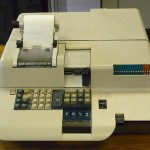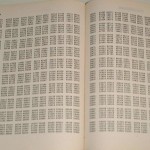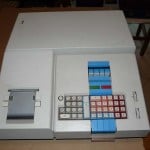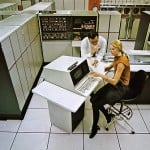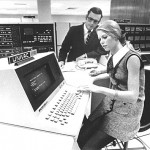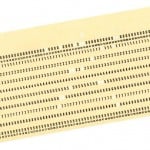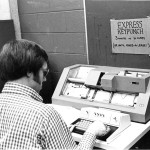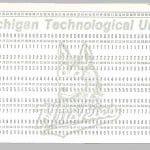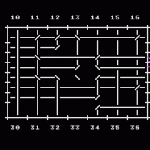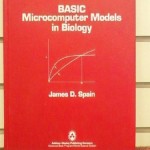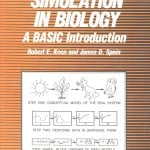by James D. Spain (Written Spring 2012)
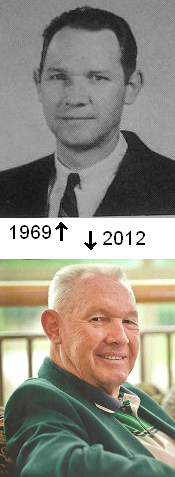
In 1969, while we were picking out the equipment for our new Chemistry-Biological Science building, one of the items that we chose was an Olivetti Programma-101. This was a programmable calculator that could be used for carrying out repetitive calculations, statistical analysis, and data analysis in general. We had little difficulty agreeing that it was something the department needed, as all recognized that this was the direction of the future. When it arrived, perhaps a year before we went into the new building, it was moved into Spain’s office to enable him to learn how to use it. It turned out to be a large, heavy piece of equipment, at least twice as big as an IBM typewriter. It could be programmed by typing in a series of two-character commands, such as A^, B+ and C<. These commands caused numbers to be moved from storage “registers” (B, C, D or E) to the accumulator (A), where one would carry out some numerical operation based on the contents of some other register, then exchange the result with what was in one of the other registers. The memory would hold 32 such commands. These commands and the contents of the registers could be stored on an 8×2-inch card with magnetic backing. The output consisted of a paper tape printout, which could list the program, print input, or data output. Since it behaved somewhat like a computer, it was called a “microcomputer”. It also might have been called a desktop computer, however that term was not prevalent at the time.
The only computer otherwise available to faculty was the “mainframe” that was being used by the engineering departments at Michigan Tech, but by few people on campus otherwise. One other computer on campus was an analog computer which one wired up to solve differential equations with electrical circuitry. It was popular with some faculty in the Math department; there was no Computer Science Department at that time.
After copying a few canned statistical programs into the P-101, Spain began to try programming a few things for himself. Soon, he discovered that it had the capability of looping around and carrying out repetitive operations. He then asked himself if it could carry on an exponential growth process, by taking a fraction of a number, adding it to the number and repeating the operation again and again, printing out the results of each step. Since it did this easily, he began to try various other phenomena observed in population growth and in biochemical kinetics. Amazingly, everything he tried seemed to produce data almost identical to real systems. “Wow.” he said, “I wonder if other people know about this?”
Well, he looked in the literature and couldn’t find any mention of it, even in the journalSimulation. At about that time the first Conference on Computers in the Undergraduate Curriculum was scheduled and organized at the University of Iowa, so Spain submitted an abstract for a paper on his simple simulations. Surprisingly, it was accepted. When Spain presented his paper, he found he was the only person presenting anything in biology,and one of the very few in chemistry. Suddenly, he was rubbing shoulders with the “movers and shakers” involved in applying computational techniques in the basic sciences. One of the people he was to meet was Hal Peters, the director of CONDUIT, an organization of universities to increase the transport of software between different mainframe systems. Little did he realize how important his friendship with Peters was later to become.
As a result of these contacts, Spain was invited to be the chairman of the session on “Computer Applications in Biology” at the following convention to be held at Dartmouth College. The work that he had presented in Iowa was subsequently written up and accepted for publication in the journal [i]Simulation[/i]. It is amazing, in retrospect, that Spain was able to go so far as a result of a few hours playing around with this primitive computer.
In addition to the deterministic simulations on processes such a population growth, he also became interested in the simulation of random events by using random numbers, or at least what he had invented to serve as random numbers. Initially, these were produced by using a sequence of mathematical operations on a seed number to produce a product that one was unable to predict. He was later to find that this is true even for the most sophisticated random number generators, the only difference being in the sophistication of the mathematical operation. Initially, he wanted a random number simply to determine the occurrence of a particular play during a simulated football game he had invented. One of his initial interests was to devise ways to determine how random his “random numbers” actually were. At first, he did this by writing down long lists of numbers and counting how frequently certain digits were repeated. Later, he wondered if anyone else had been interested in this sort of thing. It was then that he discovered a thick black book in the library published by the Rand Corporation that consisted of page after page of computer-generated random numbers, not unlike those that he had produced, and a list of tests that had been applied on them to test their behavior with what you would expect from”real” random numbers. This led him into the application of statistical analysis to the testing of random numbers.
He was later to discover that the generation of random numbers and their testing could all be done much more efficiently by the use of computers. And, that computer models based on random numbers make up a significant field of simulation in both biology and chemistry. Much later, his interest in random numbers would grow and he would find that they could also be used for the encryption of data.
In the meantime, Spain was so convinced that computer applications should be an important component of the biology curriculum that he submitted a proposal for a new course on Computer Applications in Biology. This was approved for the following year and for several years after, he taught this course using the two P-101 machines that they now had in the department. Shortly, Olivetti came out with the P-602, and the department obtained one of these as well. About this time, Spain contacted the people at the Olivetti Corporation and asked if they would be interested in discussing potential instructional applications of their equipment. This resulted in an invitation to visit their home office in New York City.
After several years of teaching students programming of Olivetti computers, Spain decided that they would be better served if they were being taught a language that was more broadly applicable to science, such as BASIC programming language, on the mainframe. So, during the next summer, Spain began learning IBM Basic Programming Language, using the UNIVAC that Michigan Tech was employing at that time. Program input was accomplished by IBM cards generated by a punch-card machine about the size of a desk. Each single line of BASIC code was punched into an IBM Card, using a typewriter keyboard, each character producing a loud chunking sound, as the holes were punched into the card. A program consisted of a stack of such cards. This stack was preceded by a couple of header cards that included a password and ID.
This stack of cards was then submitted to the computer center’sservice desk, where the computer attendants would put it into the processing queue. The user would then have to wait for it to be processed, perhaps coming back the next day if the center was very busy. On returning, you would receive a large printout, listing your errors, etc. Then, you would redo the necessary cards and resubmit the revised stack of cards. This could take several repeats to successfully get a single program to run. The process was especially frustrating if the program didn’t run and wouldn’t tell you why it didn’t run, such as when the Computer Center changed your ID or their mode of operation for some reason. Sometimes, after an exasperating discussion, you would find that your password was no longer valid and they would say, “We explained that in the October News Letter, didn’t you read it?” Of course it hadn’t been read it, since most of it was largely unintelligible.
Despite all this, Spain lived with (at?) the Computer Center for a couple of years. In 1978, he felt confident enough to offer a College Teacher Workshop on Computer Modeling in the Life Sciences. This was arranged by the Continuing Education Department and came off very well, using the course materials that he had developed for his department course. It was attended by 12 faculty, representing colleges from various parts of the country. The whole operation was set up in a classroom in the computer center. One of the people who came to this initial workshop was Brian Winkel, an applied mathematician from Rose-Hulman Institute in Terre Haute, IN. He became so interested in what we were doing that he came back for a sabbatical year at Michigan Tech, teaching in the math department and becoming a friend and colleague for the remainder of Spain’s life.
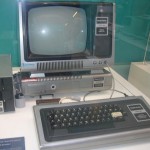
About this time, several companies were beginning to introduce small computers that had significant memory and video output. An especially popular one that employed BASIC was Radio Shack’s TRS-80. It had 8K of memory, a cassette recorder for storage of programs and a black-and-white screen. In addition, some low-resolution graphics, including crude curves, could be displayed, as they were being generated. Somehow, Spain was able to get one. Now, he had total control of programming, right on his own desk. He was no longer hassled by passwords, ID numbers, changes in operation, etc. As soon as he was able, he discontinued his relationship with the MTU Computer Center.
He set about transferring all of his simulation programs to this platform. Every day was a new thrill, as curves were generated on the screen with so little effort. One day during Christmas Break, when he was in the Bio-Science building alone, he set about transferring his curve-fitting program to the TRS-80. When it got close to lunch time, he called his wife to tell her that she better go ahead and eat lunch, as he had a few more things to do. However, everything that he did, suggested something else that would make the program just that much better. So, on and on he went; adding this; checking that; when all of a sudden, he looked up and discovered that it had gotten dark outside his window. It was then that he realized that he had been sitting at his desk, first turning to the computer, then turning back to his scratch material, then back to his computer, etc., while never having once gotten up to eat or go to the bathroom for the entire day! He had never been so absorbed in anything in his entire life.
The following year, with the help of Brian Winkel and a student, he set up two workshops, one for college faculty and one for high school science teachers. These were supported in part by NSF, but also by Radio Shack, as they loaned Michigan Tech 30 TRS-80s for use during the workshops. These were described in the brochure as Microcomputers and Modeling in Undergraduate Life Sciences. On the weekend before the workshops were to commence, a truckload of boxes arrived and in only a couple of hours, we had set up and had running a complete computer center, with 30 work stations. These were fun sessions, as the three instructors learned as much as the students, due to the many computer tricks that participants brought with them.
During this period and in subsequent years Spain was writing programs at what seemed like one-a-day (but probably, more like one a week). These, of course, were simple programs; things like using random numbers to describe the path of a worm moving around the screen; using random numbers to play a game of paper-rocks-scissors, analysis of a pendulum, describing a path of a satellite orbit, firing a cannon, etc, etc. Spain’s conclusion was that there was nothing you could not do with a computer, if it had any basis in mathematics. And, that the computer was the all-purpose toolbox for making things that behaved like the real world and testing ideas about real-world behavior.
In 1979, Spain submitted three interdependent proposals to the National Science Foundation. The main one was to carry on a project to develop 20 simulations that could be used for undergraduate biology instruction. It was named the SUMIT Courseware Development Project. The word SUMIT stood for Self-contained Undergraduate Modular Instructional Technique, which was sort of meaningless, but gave a salable acronym. The second proposal was for 10 TRS-80s that would be used for testing the material in biology classes. The third proposal was for three undergraduate workshops that would be used for dissemination of information about the completed simulations. Although, these proposals were submitted to separate divisions of NSF, each mentioned the other and apparently met with the approval of all three reviewing committees.
![Apple ][+ computer](https://blogs.mtu.edu/biological/files/2012/03/IIplus-150x150.jpg)
Soon after the SUMIT project was begun in 1979, three excellent graduate students named Ted Soldan, Cathy Leece, and Mark Shaltz enrolled. The other faculty member involved in the project was Dr. Ken Kramm. The 20 proposed projects were parceled out to the five staff on the project and they began working on them. The funds were used to provide summer salaries for the two faculty and stipends for the three graduate students. Unfortunately, Ken Kramm left the department after the first year. However, he had completed much of his assigned work and so he was not replaced. During the following two years, the SUMIT group was able to complete about a dozen modules. The graduate students wrote master’s theses describing the planning and development of these projects to complete the requirements for the MS degree in Biological Sciences. The students assisted in the 1980, 1981 and 1982 workshops.
About 10 modules were submitted for review by CONDUIT and the following year, Spain went on sabbatical and spent the bulk of his time getting the modules ready for publication. In the end, eight instructional modules were published. The remainder of the simulations were made available to workshop participants and the general educational community on computer disks available from Michigan Tech. The eight modules developed by SUMIT made up the bulk of CONDUIT’s biology offering between ’84 and ’90. Unfortunately, all but one of these was available only for use on the Apple II computer, which was beginning to be supplanted by the new IBM-PC. It is only hoped that in addition to being used for instruction, they played some role in future developments in instructional computing. Although this sounds like we fell far short of our goal, it was exceptionally high productivity compared to most NSF projects, which were usually designed to produce a single product.
Ironically, one of the published modules, called “Baffles”, was not among the original 20 proposed. However, it was a game that had significant application in teaching students the principles of scientific inquiry and deductive reasoning. It was based on a physical game called “Black Box”, in which one discerns the location of objects in a closed box by probing it with sticks. With Baffles, all of the objects are reflectors that can either deflect a beam to the right or to the left when “laser” beam probes are directed at one of forty points around the perimeter of the box. By analyzing the place where the beams exit the box, the goal of the player was to deduce the location and tilt of each “Baffle”. This becomes quite challenging when the number of baffles is increased to a point where almost all exit beams are the result of multiple hits. The score was based on the number of beams that were required to correctly locate all the baffles. The amount of time required was not a factor. This was sufficiently popular that it was made available for both the Apple II and the IBM-PC computers. It also led to some spin-off games of a similar nature by other authors. This serendipitous outcome turned out to be the most important result from the SUMIT project.
Spain decided to use the same principles in a reverse fashion to design a computer game called “Lazer Maze”. In this game, the player was allowed to see the location of a bunch of reflective baffles that were randomly placed in an open box. Then a beam was fired into a randomly determined location. The objective was to predict, as rapidly as possible, where the beam would emerge from the box. This produced an exciting game that was tested on a number of students and friends. It appeared to be much more interesting to females than males. Up to that point, computer games were mainly based either on sports or war games and hence were mainly enjoyed by males. Was Lazer Maze perhaps the long sought computer game that appealed to females? Somehow Spain had gotten the name of a company called Avante Garde, in Portland, Oregon, and knew that their president was named Mary K. Smith. So, he sent them the disk and waited for a response. Shortly, he got a call from some computer nerd who said that the program worked fine, but they really had no interest in it since it just wasn’t the kind of game they published. Spain asked if the president had reviewed it and he said that she hadn’t. So, Spain asked if he would get her to do so. He grudgingly said,”OK” and hung up. In about 30 minutes Spain had a call from Mary K. Smith, who was really enthusiastic about the program, saying that she thought it had the potential of starting a”whole new genre of computer games.” and that they definitely wanted to publish it. Then, she put the programmer back on the phone and he said that he would soup it up a little by putting in some “laser sounds” and making it so that an alien was killed when the laser came out the other end.
Spain wasn’t crazy about the “alien” part of it, but in about a month, the revised product came back for his approval and even though it had lost some of its feminine mystique, he wasn’t going to argue at that point, so he signed the contract and returned it. Laze Maze sold for a couple of years, during the life time of Avante Guard company.
Meanwhile, Spain continued to offer summer workshops for both college and high school teachers. In 1982, Winkel and Spain were joined by Jim Randall, from Indiana University, who had written a text on Microcomputers and Physiological Simulation. In 1983 Winkel and Spain were joined by Tom Coleman from Univ. Mississippi and in 1984 it was Winkel, Randall & Spain again with 24 participants. Over the seven-year period ’78 to ’84, there were a total of about 120 participants representing 105 colleges and universities. There were at least an equal number of high school teachers who were involved in high school workshops. It was gratifying to see the interest that had been generated and to have played a role in the general application of computers to science education in both colleges and high schools.
During his teaching in biological sciences Spain had gradually gathered instructional materials for the students to use. This was printed up annually by the MTU print shop and sold to students at cost. After several years, he began to look for a publisher and in 1980, Addison-Wesley agreed to publish a book on the subject, if camera-ready copy of the manuscript could be provided. About this same time, Brian Winkel and his wife, Phyllis, were on sabbatical in Houghton, so they agreed to produce the camera-ready copy for Spain. This was great as they already had experience publishing a journal called Cryptologia. Fortunately, Brian and Phyllis helped with the many mathematical equations and his friend Ed Williams from Chemical Engineering agreed to go over the English and logic that he had employed. So, all in all, Spain had much more help than he would have ever gotten by sending a manuscript to a publisher. The result was that his 1982 simulation class had a published text to work from, called BASIC Microcomputer Models in Biology. Soon, he was receiving comments from faculty who had either used the text in their class or had, at least, read it. Several years later, he had more citations in Citation Index from Basic Microcomputer Models in Biology than from the twenty-five research papers he had struggled to produce.
About this time, a new faculty member, Dr. Robert Keen, joined the Computer Applications Group. His primary interest was in use of computers for statistical analysis and so, began teaching a course on this subject. He was also interested in modeling and simulation, so that when Spain went on sabbatical in 1983, he assumed the responsibility for the simulation course and wrote anInstructor’s Manual to Accompany Basic Microcomputer Models in Biology. This book was remarkable in that it was twice as thick as the original text. The year after Spain returned from his sabbatical, he decided to take early retirement from Michigan Tech and continue his career, first at Eastern Michigan University, as their director of Instructional Computing and later at Clemson University in South Carolina, where he directed the Chemistry Learning Center. When he retired from classroom teaching, he and his wife began a publishing company, Electronic Homework Systems, Inc, which produced over 700,000 computer disks that were sold through bookstores at colleges and universities around the country. He retired in 2010.
After Spain left Michigan Tech, Keen took over responsibility for the simulation course, which he greatly expanded. He subsequently assumed senior authorship of a revised text that was published in 1991 by John Wiley. This text, Biological Simulation Techniques: A BASIC Approach, by Keen and Spain, is still being used at a few schools around the country.
